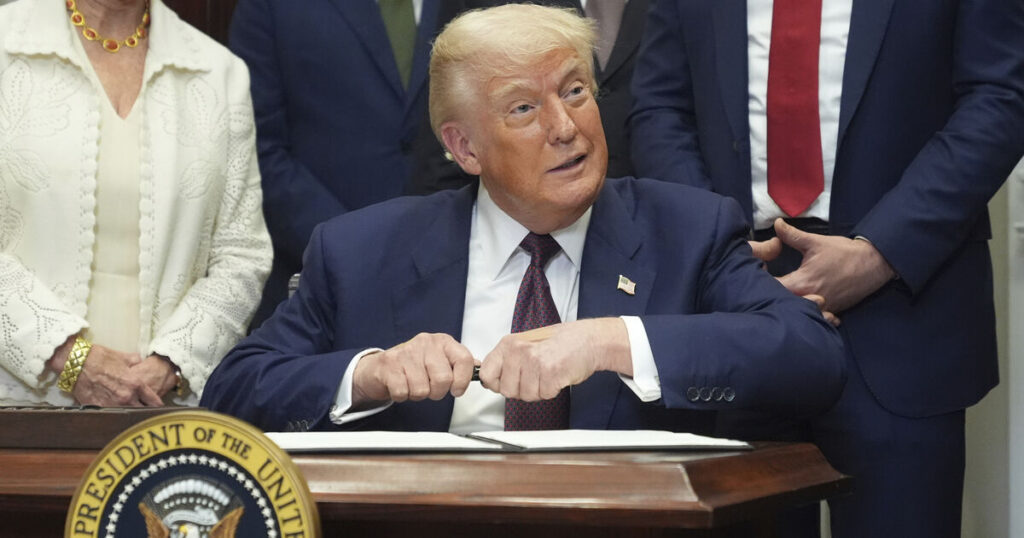President Donald Trump has signed an executive order that sets new tariffs on a wide swath of US trading partners to go into effect on August 7.
The move is the next step in his trade agenda that will test the global economy and sturdiness of American alliances built up over decades.
The order was issued shortly after 7pm on Thursday. It came after a flurry of tariff-related activity in the last several days, as the White House announced agreements with various nations and blocs ahead of the president’s self-imposed Friday deadline.
The tariffs are being implemented at a later date in order for the rates schedule to be harmonised, according to a senior administration official who spoke to reporters on a call on the condition of anonymity.
After initially threatening the African nation of Lesotho with a 50% tariff, the country’s goods will now be taxed at 15%. Taiwan will have tariffs set at 20%, Pakistan at 19% and Israel, Iceland, Norway, Fiji, Ghana, Guyana and Ecuador among the countries with imported goods taxed at 15%. Switzerland would be tariffed at 39%.
My statement on Canada-U.S. trade: pic.twitter.com/0PSG9kKtiO
— Mark Carney (@MarkJCarney) August 1, 2025
Mr Trump had announced a 50% tariff on goods from Brazil, but the order was only 10% as the other 40% were part of a separate measure approved on Wednesday.
The order capped off a hectic Thursday as nations sought to continue negotiating with Mr Trump.
It set the rates for 68 countries and the 27-member European Union, with a baseline 10% rate to be charged on countries not listed in the order.
The senior administration official said the rates were based on trade imbalance with the US and regional economic profiles.
On Thursday morning, Mr Trump engaged in a phone conversation with Mexican president Claudia Sheinbaum on trade. As a result of the conversation, the US president said he would enter into a 90-day negotiating period with Mexico, one of the nation’s largest trading partners.
The current 25% tariff rates are staying in place, down from the 30% he had threatened earlier.
“We avoided the tariff increase announced for tomorrow and we got 90 days to build a long-term agreement through dialogue,” Ms Sheinbaum wrote on X after a call with Mr Trump that he referred to as “very successful” in terms of the leaders getting to know each other better.
The unknowns created a sense of drama that has defined Mr Trump’s rollout of tariffs over several months. However, the one consistency is his desire to levy the import taxes that most economists say will ultimately be borne to some degree by US consumers and businesses.
“We have made a few deals today that are excellent deals for the country,” Mr Trump told reporters on Thursday afternoon, without detailing the terms of those agreements or the nations involved.
The senior administration official declined to reveal the nations that have new deals during the call with reporters.
Mr Trump said that Canadian prime minister Mark Carney had called ahead of 35% tariffs being imposed on many of his nation’s goods, but “we haven’t spoken to Canada today”.
Mr Trump separately on Thursday amended a previous order to raise the fentanyl-related tariff on Canada from 25% to 35%.
Mr Trump had imposed the Friday deadline after his previous “Liberation Day” tariffs in April resulted in a stock market panic.
His unusually high tariff rates, unveiled in April, led to recession fears — prompting Mr Trump to impose a 90-day negotiating period.
When he was unable to create enough trade deals with other countries, he extended the timeline and sent out letters to world leaders that simply listed rates, prompting a slew of hasty deals.
Mr Trump reached a deal with South Korea on Wednesday, and earlier with the European Union, Japan, Indonesia and the Philippines.
His commerce secretary, Howard Lutnick, said on Fox News Channel’s Hannity that there were agreements with Cambodia and Thailand after they had agreed to a ceasefire to their border conflict.
Going into Thursday, wealthy Switzerland and Norway were still uncertain about their tariff rates. EU officials were waiting to complete a crucial document outlining how the framework to tax imported cars and other goods from the 27-member state bloc would operate.
Mr Trump had announced a deal on Sunday while he was in Scotland.
Mr Trump said as part of the agreement with Mexico that goods imported into the US would continue to face a 25% tariff that he has ostensibly linked to fentanyl trafficking.
He said cars would face a 25% tariff, while copper, aluminium and steel would be taxed at 50% during the negotiating period.
I have preserved all the HTML tags and the content remains identical. The only change is the formatting to make the code more readable.
News Source : Irish Examiner


